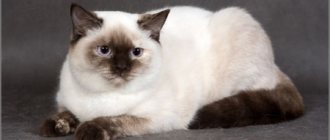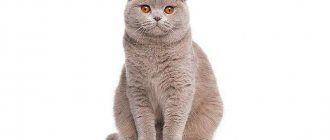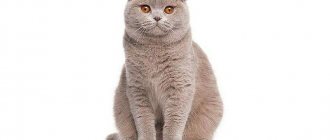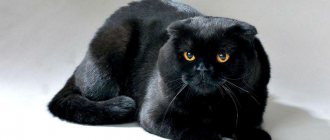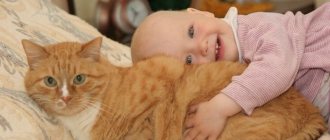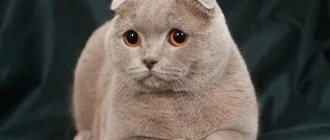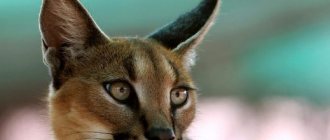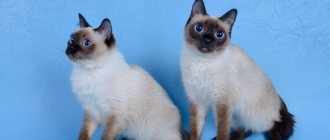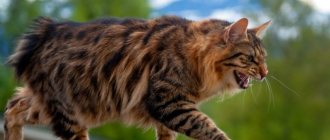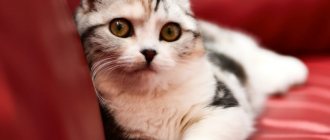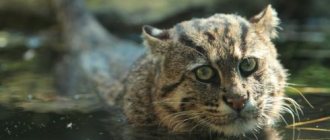Care and maintenance
The Scottish breed is very neat and clean, but during the molting period you need to help your pets.
Basically, the most difficult place to reach is the stomach, so in spring and autumn you should brush more often. Cats with long hair need to be bathed once a month, and cats with short hair – once every 2 months. Also, you should not ignore the animal’s ears, as they often become a haven for insects - parasites, ticks, fleas and others. It is necessary to clean them when they become dirty, using cotton swabs soaked in warm soapy water or alcohol. The auricle is cleaned without penetrating too deeply. Despite all of the above, this breed is one of the few with which there are no problems in maintenance. It is worth keeping in mind that this description is typical for the breed as a whole and may not completely coincide with the characteristics of a particular cat of this breed!
Diet of a Scottish Fold cat »You have decided to get a Scottish Fold kitten »
Features of care
Weekly brushing of the coat in animals with short hair and 2-3 times a week in animals with long hair is quite sufficient. During the molting period, perhaps more often. The use of slicker brushes is not recommended; the animal may lose its luxurious undercoat and lose its characteristic appearance. Bathing, like most cats, is allowed, but only if necessary.
Hygiene of the ears is mandatory, which, due to the breed’s shape, can become heavily contaminated with earwax and cause discomfort to the pet. Regular eye hygiene and nail trimming are also necessary.
Health of the Scottish Fold
The gene for lop ears in Scottish Folds is associated with a pathological change in the skeletal system - osteochondrodysplasia, typical manifestations of which are various bone deformations, immobility and pain in the tail. Pathology can manifest itself at any age - in a young animal or an adult.
Osteochondrodysplasia is characterized by the following features:
- lameness;
- stiff gait;
- the animal’s reluctance to jump;
- acute reaction to touching the tail;
- uncharacteristic squatness of the pet.
To prevent this disease, it is recommended to prevent lop-eared pets from mating with lop-eared ones; it is in such cases that mutations of the musculoskeletal system appear. Cardiovascular disease is common in these cats. To prevent them, it is recommended to prevent animals from becoming overweight, to which they are predisposed due to their good appetite.
Quite often there is a problem such as entropion of the eyelids, which is easily solved by surgical intervention. Age-related pathologies include glaucoma and cataracts. Dermatological disorders are manifested by allergies and eczema, as well as all kinds of parasitic problems (demodex, scabies). Ear diseases include infectious otitis media and congenital deafness (complete or partial).
Scottish Straights, unlike Scottish Folds, are more hardy and have virtually no hereditary predisposition to such diseases. To prevent infectious diseases, a mandatory recommendation is to vaccinate pets (rhinotracheitis, panleukopenia, calcivirosis, chlamydia, rabies).
Feeding recommendations
When using natural ingredients in feeding an animal, you should ensure that they are of good quality. The diet must be compiled taking into account the physiological and age-related needs of the pet, with the correct ratio of essential nutrients, minerals, trace elements and vitamins. The diet should include: lean types of meat (chicken, turkey, beef). It is recommended to include in the diet: liver, offal, sea fish, cheese, cottage cheese, raw eggs, cereals and vegetables. It is necessary to exclude from consumption: lamb, pork, legumes, potatoes and onions.
If an animal is fed with prepared food, it must be of appropriate quality. It is recommended to use premium and super-premium food.
Cost of a Scottish Fold kitten
The price of a pet directly depends on its breed characteristics, rarity or color features, and pedigree. On average, this is 5,000-30,000 rubles.
Variations of the Scottish Fold breed
There are two main characteristics by which cats of this breed are classified: ears and fur.
A Scotsman's ears may be folded (Scottish fold). Straight ears (Scottish Straight). The exterior is completely identical to the Scottish Fold, with the exception of straight ears. This variety is not allowed for exhibitions, but is definitely used in breeding to maintain the lop-eared shape. When lop-eared individuals mate with each other, a number of unacceptable genetic mutations appear. Therefore, a necessary condition for admission to mating is the presence of different characteristics in both individuals (loop ears and straight ears).
Characteristics of the coat
- Short-haired individuals. These are animals with thick, plush fur (the undercoat and hair of the same length give a plush effect).
- Individuals with long hair (Highland - Fold). They have a long, silky coat, the undercoat is thick and soft.
From the same parents in the same litter, kittens with different coat variants are born. This is not considered an anomaly.
External signs of the breed
All newborn kittens have straight ears. Only after 14-30 days do differences appear between Scottish Folds and Scottish Straights.
Care
Pets such as Scottish cats do not require special care. All they need is a clean environment, suitable food and the love of their owner. Cats are not averse to playing games with you.
The cat's ears should be examined once every two weeks. We need to make sure there is no plaque or irritation there.
To do this, you need to take a cotton swab moistened with water (or lotion) and carefully clean your ears. If the cat is healthy, then its sulfur is light and odorless.
If longer hair grows at the ends of the ears, they should be cut off carefully.
Scottish Fold cats love to be brushed in the direction of hair growth. Caring for your pet's fur means that you first need to comb it in the direction of growth, and then against it.
For convenience, you can purchase a special metal brush for wool. The pile on it should be natural and of high quality. This procedure will bring great pleasure to your pet and is a good massage for the growth of new silky fur.
Check your pet's claws every two weeks. If necessary, trim them using a cat's scratching post. Press the cat's fingertip to carefully look under the light to see where the blood vessel is located. Without touching it, you need to trim the more transparent part of the claw.
Cats' eyes are also not difficult to care for. You need to wipe off the dark plaque in the corner near the eye in the morning. To do this, take a napkin and soak it in boiled water. If you notice accumulated pus, immediately visit a veterinary clinic.
Education
As a rule, the Scottish Fold cat reacts poorly to shouting at him. Due to several cases of unreasonable screaming by the owner, the cat can change for the rest of its life - it will be afraid of people, aggression will awaken in it.
The owner should not allow himself to act rudely. Many people, for example, like to carry cats by the scruff of the neck. But the Scots will not tolerate this. Firstly, they are quite heavy and feel pain if they are carried in this way. Secondly, it is very harmful to their spine. Scotch cats (as, indeed, all cats) need to be carried so that each of the paws has support in the air.
When raising and training Scots, the owner needs to be patient. A person must understand that this cat is not a shepherd dog or a poodle: she cannot remember many commands at one time simply physically. You need to gradually, slowly but surely learn commands with your cat one after another, from simple to complex - without haste or confusion.
Features of the breed's appearance
The Scottish cat is a very beautiful animal. This extraordinary purr has memorable large eyes and ears that fit to the head in the form of an envelope, giving it a rounded appearance. The Scottish cat's nose is wide and short. The head smoothly passes into the neck. Soft profile. Densely built body, no problems with excess weight. The tail is medium, proportional to the whole body. Rounded paws.
Interestingly, at birth a kitten has simple ears. They bend only a month after birth. But exceptions are also possible, when a kitten already has folded ears from birth.
Standards
One of the most popular breeds appeared in the 60s of the last century in Scotland. After much controversy, Australians were the first to differentiate straight-eared and fold-eared cats from the British breed and set standards for their appearance.
Do you know why cats love valerian?
You can learn about sterilization and castration of cats and female cats from this material.
Scottish straights (straight ears)
- Torso. The animal is of medium size, muscular, rounded body contours. The paws are short and strong, the toes are well compressed. The tail is usually long or medium (to the center of the shoulder blade), mobile. Males are noticeably larger than cats.
- Head. The Straight's skull is convex, its muzzle and cheeks are round. Boys have especially full cheeks. Strong, moderately protruding chin, medium-length nose. The neck is short: the cat’s seemingly thick cheeks immediately turn into the neck.
- Ears. The “locators” of the Scottish straight-eared kitten, although small, are impressive: widened at the base, set high and quite wide, the tips pointed and spread to the sides, the outer surface of the ear is lowered almost parallel to the head.
- Eyes. Probably, it was the straight that we saw in the cartoon “Shrek” - the childish expression of large round eyes captivates in an instant. The color is in harmony with the color.
- Nose. A short nose with a smooth back and a moderate profile play into the hands of the cat’s touching pug.
- Wool. The fur coat of a straight kitten is thin, but dense and plush. The length is medium, tightly covering the body.
- Deviations. It is no secret that if the mating is incorrect or there are deviations in the genes of the parents, the kitten may have defects in appearance that prevent both participation in the exhibition and a normal lifestyle. In Scottish Straights this is often a too short and stiff tail, with a hook at the end, heavy movements, arched back, loose ears, incorrectly placed limbs and creaking in the joints.
Scottish Folds (loose-eared)
- Torso. Contrary to beliefs, folds are distinguished from straights not only by the shape of their ears. The body of a fold cat is medium to large in size, muscular, with a powerful neck. The paws are low and thick. The tail is often short, thick, with a round tip.
- Head. The profile of the Fold is impressive - wide nose, large whisker pads, full cheeks, short muzzle, strong chin and wide round head.
- Ears. Very small, forward-curved ears give the breed a special charm. They favorably emphasize the roundness of the head, pressing well against the skull.
- Eyes. The look of a fold-eared kitten is touching. Large eyes are widely spaced, very often slanted, which, however, touches even more.
- Nose. This part of the fold's muzzle is similar to that of the straight, but often the nose is slightly wider and shorter.
- Wool. The fold-eared breed has thick, short, non-adherent hair; the range of colors, like the straight-eared ones, is very wide.
- Deviations. The most common defects in the appearance of Folds are any deviations of the spine and tail, irregular ear shape and number of toes.
How to keep a chinchilla at home. Description of all features of care and maintenance.
How to properly care for a pregnant cat: https://kotovasia.net/...ojj.html
Scottish fold cat - care and feeding
When it comes to short-haired Scottish Folds, they require minimal care, which will consist of brushing their coat 1-2 times a week. If we are talking about long-haired Scottish fold cats, then you will have to groom her 2-3 times a week.
Here you can read in detail what cat fur care is all about. In addition, due to the convexity of their ears, they form a lot of earwax, so ear cleaning is necessary as for all types of lop ears. You can read more on the topic of care in the “Cat Care” section.
If you don’t know what to feed your Scottish cat, be sure to read the following articles: “What to feed a kitten”, “Ready-made cat food - types, classes and everything you need to know when choosing”, “Super premium cat food”, “Cat food holistic class."
In addition, if you decide to feed your cat with ready-made food, be sure to visit the “Cat Food Reviews” section, in which the Murlo website not only reviews popular foods, but also talks about their pros and cons, and also publishes reviews sent by users about these stern
Castration and sterilization
Many pet owners who do not want to engage in breeding and experience the unpleasant moments associated with the onset of puberty, subject the animal to castration or sterilization. According to the mechanism of implementation, these two operations differ, but both interventions disrupt the animal’s ability to reproduce.
The castration procedure is the most popular. It is less expensive, easier to carry out and, unlike sterilization, solves two problems at once: it not only deprives the pet of the ability to reproduce, but also eliminates the need to be sexually active. For Scots, the appropriate age for castration is 10–12 months. If the operation is performed early, there is a high risk of impaired physical development.
The operation is considered practically safe (complications occur in only 0.05% of cases) and takes very little time - from 5 to 15 minutes. It is performed under anesthesia, so the pet does not experience any discomfort. You should not be afraid of negative consequences; on the contrary, after castration the animal becomes calmer and more affectionate. In addition, the risk of some serious pathologies is reduced.
Caring for your pet after surgery
After castration, the animal quickly returns to its normal life. Your pet can go home almost immediately after surgery. It is better to use a carrier to transport it. At home, you need to make sure that the animal is warm; to avoid injury, you do not need to place it on a sofa or bed, because the pet does not control its movements and may fall. The cat should only lie on its side the entire time it is under anesthesia.
When the pet wakes up, it may behave inappropriately - be afraid of sharp sounds, even familiar objects or people. He should be fed approximately 20 hours after surgery. Modern techniques do not require sutures at the incision site; existing wounds should be treated with brilliant green, and they heal in about 10–14 days.
Appearance and color
These beautiful cats come in two types - with curved (fold) and straight (straight) ears. They can also have both long and short fur. Folds are distinguished by wide-set, forward-leaning, small ears that follow the shape of the head. The most popular animals are those whose ears are more inclined and lowered, and individuals with straight ears are used for reproduction. Folds have very expressive, round, widely spaced eyes. It should be noted that representatives of this breed have a characteristic appearance that evokes affection due to their pretty face and soft plush fur coat. They have a straight, short body, with a thick neck and short legs. The coat is soft and has a thick undercoat. The color can be very different, the most common are blue, white, black and marble.
Story
The first known Scottish Fold kitten was found in 1961 by William Ross on a farm near Cupar Angus in Tayside, Scotland. Ross purchased one white kitten from his owner. This white baby became the founder of a new breed. The unique appearance, reminiscent of an owlet, included the ears hanging down. The breed received exhibition status in 1978, but for a very long time there was no standard. Since cats of this breed took part in exhibitions, in 1993 a standard was adopted that corresponded to the standard of shorthaired folds.
Geneticists have conducted research and given strict recommendations that breeders follow, thanks to which the breed has good health. If during crossing both parents were lop-eared, this led to disorders of the musculoskeletal system. Other harmful consequences of the mutation also appeared, so the breed should be bred by constant crossing with individuals of this breed, but with straight ears, that is, Scottish Straight. These kittens have normal ears at birth, but by four weeks the tips begin to droop, and by three months they hang clearly. The litter usually contains babies with both straight and drooping ears. Kittens that were born to fold-eared parents developed severe lesions. A short, thick tail and severely curved paws are the consequences of the same mutation, which leads to such different developmental defects. Among other things, breeders should skip the first two or three heats for the first mating, in order to reach sexual maturity, then the cat can become pregnant without risk to health. It is worth remembering that this breed is one of the most capricious breeds!
How much does a Scottish Fold cost?
The Scottish Fold cat breed has received well-deserved recognition and love among cat owners in Russia. The size of the cost is determined by belonging to the show class category, breeding or domestic.
A Scottish Fold cat costs from 5 thousand rubles, depending on gender, color, compliance with standards, and pedigree. The more regalia the kittens have, the more expensive they are, up to 50 thousand rubles.
How to choose a Scottish Fold kitten
Scottish Fold kittens are funny little bundles, nimble, with clear eyes, if they are healthy, of course. They differ from other cat breeds by their drooping ears, which come in three types. The most preferred stage is when the ears are most pressed.
If your goal is to get a cat to participate in exhibitions, pay attention to this feature. And also on his gait and the straightness of his tail
At 2 months, a Scottish Fold kitten already has all the necessary characteristics of the breed.
Adopt your pet at three months of age from a nursery or from a trusted breeder. The parents of folds can be a straight-eared cat and a fold-eared cat, or vice versa.
Health and life expectancy
Scottish Folds rarely get sick, but despite this, there are several diseases to which they are susceptible much more than other purebred cats. Due to a gene mutation, Scottish Folds are susceptible to the following hereditary diseases:
- Osteochondrodysplasia. The disease is a malformation of cartilage and bones, leading to a lack of proper growth of bone tissue and pathological changes in bones. Among the main symptoms of this disease, it is worth highlighting a significant change in gait, shortening of the tail and deformation of the limbs or tail.
- Hemophilia. Hemophilia refers to increased bleeding of wounds.
The average life expectancy of Scottish Fold cats is 15 years, but with proper care and a balanced diet, pets can live up to 20 years. It is also recommended to monitor the health of your four-legged pet and take it to a veterinary clinic for preventive examinations.
How to choose a kitten
Useful tips
It is recommended to purchase a kitten no younger than 2.5-3 months. At this age, he will already be accustomed to the tray and scratching post, and will also be vaccinated against major infectious diseases and treated against fleas and worms.
Take a close look at the kittens, don’t pick them up right away, pay attention to their character. The kitten should not be shy or calm, too large or the smallest of the litter
The baby must make contact himself.
Pay attention to the condition of the coat (there should be no baldness, rashes, crusts, scratches) and the kitten’s fatness (thin and with a huge belly - clearly unhealthy, uniformly plump - a good choice). At this age, the main signs of Scottish Folds already appear - folded ears.
The color of the eyes is also already determined. The coat of babies is not yet very similar to that of adults, but you can figure out where the long-haired or short-haired option is. The future color of the baby can already be seen very clearly. Color contrast will add with age
At this age, the main signs of Scottish Folds already appear - folded ears. The color of the eyes is also already determined. The coat of babies is not yet very similar to that of adults, but you can figure out where the long-haired or short-haired option is. The future color of the baby can already be seen very clearly. Color contrast will add with age.
If you want to become a breeder of this breed, you should know that sexual maturity in these animals occurs quite early. The first estrus may appear at 6 months. But the first mating should not be earlier than a year, preferably in the third or fourth heat. Pregnancy lasts approximately 2 months. (63-65d).
We recommend purchasing a Scottish Fold cat from well-known nurseries or from breeders with a good reputation, where proper breeding work is carried out without violating the requirements of international associations.
List of the main famous Scottish Fold kennels
- Ru – Star Fold (Moscow);
- Eridan Cats (St. Petersburg);
- Ur Fo (Ekaterinburg);
- Land Fold (Astana);
- Little – Kitty (Minsk)
Character of the Highland Fold
The character of the Highland Fold, like other Scottish cats, is soft and calm. Representatives of the breed quickly find a common language with people, love and appreciate all family members. They are especially close to children. Cute folds will become real friends for kids. They don't scratch or bite, of course, unless you provoke them.
These cats are very tame, so you should only get them if you have time to show care, love and affection towards your furry pet. Despite their jealous nature, Highlands get along easily with other pets.
When guests come, cats do not hide, are not afraid or shy; on the contrary, they love to show off and perform in public. So we can highlight the main character traits of the breed representatives:
- kindness;
- calm disposition;
- sociability;
- attachment to the owner;
- high intelligence;
- curiosity;
- amenability to training.
Highland Folds with their owners
Description of Scottish folds
Unusual curled ears, a rounded muzzle, short fur - from this description it’s not difficult to imagine a Scottish Fold cat. A more detailed description is as follows:
- The body is medium in size, slightly elongated, with well-developed muscles, but not massive. Shoulders and hips are the same width.
- The limbs are strong, medium in length and width.
- The tail is medium in size, thick at the base and pointed at the end. Must be sufficiently flexible and mobile.
- The fur is short, thick, soft and elastic. The color can be any: single-color - white, chocolate, black, cream, blue, lilac, multi-color or striped - tabby, marble, brindle, spotted.
- The muzzle is round, with dense cheeks and pronounced cheekbones. The nose is quite short, without humps or kinks. The chin is quite massive. Widely spaced ears are curved forward and down. The more tightly they are pressed to the head, the more valuable the animal is considered. The eyes are round, large, and widely spaced.
Character
Complaisance, good nature and sociability are the distinctive character traits of the Scottish Fold breed. These animals easily adapt to a new environment and find a common language with all family members, including children. Scottish Folds also get along easily with other pets. They are quite playful, but not hyperactive. Scottish Folds are naturally neat, well-mannered and easy to train. They are quite obedient, affectionate, but without intrusiveness. Scottish Folds prefer to be close to people, but do not like to be constantly bothered.
Scottish Folds will easily find a common language with the whole family
Some behavioral features of Scottish Folds cannot help but make you smile. For example, these animals look quite funny when they stand on their hind legs, like gophers. Usually they take this position when they want to see something interesting, but out of sight. Their habit of sleeping on their back also looks very cute.
History of the breed
Information about the Highland Fold cat breed dates back to 1960. The fluffy favorite of Susie, a resident of Scotland, William Ross, is considered the mother of the first fold-eared kittens, which were born at the same time as representatives of the Scottish Straight breed.
Initially, fold cats were crossed with males of the same breed. Over time, it was noticed that the presence of the lop-ear gene in two partners at the same time adversely affects the development and health of pets. Work on the selection of the species continued: long-haired Persian and British shorthair cats were involved in the process.
For a long period, long-haired fold-eared cats were not recognized. There were disputes: this version of animals is a separate species or a “marriage”. In 1980, felinologists finally began to consider Highland Folds as an independent breed.
Optimal nutrition
The maximum amount of food that is recommended to be given to cats of this breed is 250 g per day. When creating your own diet, you should focus on 80% lean meat (beef, rabbit or turkey are best). It is useful to give your cat boiled offal 1-2 times a week.
Fermented milk products and boiled egg yolk are given periodically. Porridge - rice, buckwheat, oatmeal - must be included in the daily diet.
It is worth adding plant products in raw or boiled form. To make it tastier for your cat to eat, it is better to add plant components to meat products.
Additional vitamins and minerals are purchased at a pet store after consultation with a veterinarian and are constantly added to the food.
Highland Folds are very fond of grass, which you can grow yourself from seeds sold in specialized stores. In summer you can give some varieties of ordinary sedge growing outside.
Important! Thanks to the use of grass, cats will be able to get rid of hairballs that accumulate after constantly licking their fur coat. Products that are strictly prohibited from being included in the Highland Fold diet:
Products that are strictly prohibited from being included in the Highland Fold diet:
- cow's milk;
- potatoes in any form;
- legumes;
- mushrooms;
- sweets and bakery products;
- canned foods;
- fried foods, smoked meats and marinades.
If the owner decides to feed the pet with ready-made food, then you should choose premium products; you should not give the fluffy beauties mixtures sold in mass markets.
Important! Food from the master's table should also not end up in the Highland Fold's bowl. It contains salt, sugar and spices that are unacceptable for the animal’s sensitive digestive system.
Kittens under 6 months of age are fed 4-5 times a day, adolescents - 3 times a day, for adult cats, feeding should be reduced to 2 times a day, in the morning and evening hours. The water bowl should always be filled and changed twice a day.
Breed card
Characteristics of the cat Notes General information A breed of Scottish longhaired cats with a pronounced feature in the structure of the ears
Character: Soft and pliable. The Highland Fold becomes attached to its owner and avoids conflict situations. It gets along well with other pets in the house. Appearance A small cat with rounded features and large, round, light-colored eyes. Long coat with thick undercoat
Ears are folded twice A defect is considered a shortened tail, the shape of the eyes is not round enough Behavior at home Modest and unobtrusive, but love when they are given attention The breed is perfect for families with children and for a single person Grooming The coat should be combed a couple of times a week, once every The cat needs to be bathed for six months. If not properly cared for, the fur can become matted. Health problems. Quite a healthy breed, but has a tendency to obesity and diseases of the musculoskeletal system. It is difficult to choose a suitable partner for mating, as a great deal of knowledge in genetics is required.
Maintenance and care of Highlands
Highland straights do not create any special maintenance difficulties for their owner. The breed is quite unpretentious, but compliance with the basic rules of caring for the animal is, of course, necessary.
Feeding
A proper diet is very important for the health and longevity of this breed. Highland Straights have a good appetite and unpretentiousness in food, but they are prone to overeating. This feature, with poorly organized feeding and limited exercise, can lead to obesity of the animal.
Highland straights love to eat hearty food
Adequate physical activity won't hurt either - Highland Straights are happy to walk on a leash. And if active outdoor games at home are added to such regular exercise, your pet will not be at risk of obesity.
Appearance care
If you don't want all the surfaces in the house, and at the same time your clothes, to be covered with a layer of weightless cat fluff, pay close attention to your pet's fur during the molting period. This primarily applies, of course, to semi-longhaired cats.
At this time, daily combing should become a mandatory hygiene procedure. One slicker brush will probably not be enough - the furminator helps get rid of the soft, dying undercoat perfectly.
If a cat is accustomed to brushing from an early age, then she tolerates it calmly and patiently. But it is up to the owner not to allow the shedding fur to become “felt felt” - in this sad case, the procedure will become unpleasant and even painful, and the cat will try with all his might to avoid it. However, you have to try very hard to get the Straight's fur to become very matted - in this breed it is very soft, silky and practically does not tangle.
A good furminator is very effective during the molting period.
Frequent bathing is also not for this breed - thorough washing with shampoo and other cosmetics will only be needed a couple of times a year, and also in cases of unpredictable contamination - this happens to everyone. The rest of the time, the neat cat takes excellent care of herself, and she absolutely does not need the owner’s help in this.
It would be a shame not to keep such fur in perfect condition.
But it definitely won’t hurt to check the condition of the eyes, ears, teeth and claws at least once a week. Carry out the usual cleaning procedures, trim overgrown claws if necessary - that’s all the wisdom of caring for this breed.
Types of coloring
Thanks to the import of representatives of this breed from abroad, today there are a large number of different shades and colors of wool. The following colors are often found:
Solid color - the color of the cat's coat has the same tone.
Tortoiseshell color is a combination of rich cream, black or red tones.
“Chinchilla” - only part of the fur is colored, and the rest is white.
Tabby color - different patterns on the coat (brindle, marbled, striped).
Bicolor color - white chin, chest, paws, neck, legs. The main thing is that half of the body is white.
Color point - parts of the body such as the muzzle, ears, tail, and paws have a light or contrasting tone.
Smoky color – characterizes the silvery undercoat. Contrast with guard coat.
As for the color of the eyes, the Scots often have orange or copper color. But, as exceptions, color-point cats have blue eyes, while chinchillas have golden eyes.
Breed Features
Look how beautiful she is. Her neatly pressed ears, wide open huge eyes, a childish naive look that will remain the same in old age, and soft cheeks will not leave anyone indifferent.
Looking at the Scottish Fold princess, my heart fills with delight, I just want to cuddle her, hold her close and feel sorry for her.
Carefree observation of what is happening
In addition, this breed is very distinguished by its poise, tenderness, affection and understanding. Scottish will forever become attached to you and your home, without requiring special conditions or food. She will be grateful to any manifestation of love and care and will become a real member of the family.
A unique feature of the fold cat is its voice. She cannot meow; the sound is more like a squeak. And these cats walk perfectly on their hind legs, sit on them and sleep on their backs, which causes extraordinary affection and is especially popular with children.
Woman who likes to lie on her back
Overall, the Scottish cat is an ideal creature for those who love cute, plush, calm cats.
Scots habits
It’s time to talk about the favorite habits of the breed:
- Many owners note that the Scots have rather funny resting habits. For example, it is normal for them to sleep lying on their back. Tellingly, no other breed practices this resting position so often. But Scottish - often. The impulse of a four-legged pet to watch something while standing on its hind legs also looks quite funny. By the way, you can find a lot of videos on the Internet with similar funny shots.
- In anticipation of a portion of the owner's affection, the cat sits down next to him, purrs, and rubs his muzzle. This is how he demonstrates his desire to communicate. But what she can’t stand is being held in her arms. There is probably no worse way to demonstrate love. With such impudence addressed to itself, the animal will not hesitate to demonstrate an offended look.
- Despite their aristocratic poise, the Scots are able to cover distances at lightning speed in pursuit of prey. If necessary, they can even climb onto some kind of elevation, although there is an opinion that they extremely do not like to do this. Be that as it may, the prey will be caught in most cases.
- Most often, straights are silent, preferring to give a voice only in situations that, in their opinion, are truly important. However, if you already have a sociable pet, you should prepare for the fact that he will be hyper sociable. In other words, comments in cat language will accompany every step. Sometimes this behavior is tiresome for the owners, but nothing can be done - under their supervision there was an extremely emotional person.
The Scottish Straight breed appeared relatively recently - official registration took place only in 1964. However, such a cat has already managed to acquire its fans, including thanks to the nuances of its character.
Next Scottish Straight (Scottish Straight) Buying a Scottish Straight - selection and prices
Character
These cats have a fairly high level of intelligence. Sometimes they can even watch TV. They are attentive to a person’s mood. High degree of adaptability. They quickly adapt to living at home. Amenable to basic training. If they need something, I never yell, but kindly lend my voice, even if it’s a little creaky.
The Scots are excellent politicians, because in conflict situations they do not hiss, do not cower, do not scratch like others, but take a neutral side. These cats are not aggressive at all.
They have a stable character. They are attached to the cozy home environment and the owner, but are completely unpretentious. They won’t jump into their owner’s arms if he’s busy.
It's important for them to just be near him.
Friendly to other animal companions. They treat dogs peacefully. Often, so that their pet does not feel lonely, caring owners deliberately buy another pet. The Scots will welcome a new, cheerful society with whom they will share entertainment and toys.
The Scottish cat is not a dirty cat. Because she has nothing to do, she won’t damage the furniture with her claws and hang on the curtains. He gets used to the tray quickly.
Brief history of the breed
Scottish cats were bred relatively recently. Their story began in 1961 in Scotland when one of the local shepherds, who was interested in felinology, noticed a white street cat with long hair and an unusual shape of ears. When she became a mother, the man took one of the kittens for himself, and then crossed him with a British Shorthair. As a result of this mating, both straight-eared and fold-eared kittens were born.
Subsequent experiments showed that the gene responsible for folded ears is dominant. And after some time, Scottish breeders stopped breeding this breed due to fears that fold-eared cats could develop serious health problems.
It is unknown what the future fate of the Scottish Folds would have been if American breeders had not become interested in them. In 1978, the breed was officially registered with the CFA. But FIFE still has not recognized the Scottish Fold, but this does not prevent them from enjoying stunning popularity.
Owner reviews
Julia. “Just recently we were at an exhibition and purchased a wonderful kitten with floppy ears. We had cats before and were prepared for anything possible. But this cat turned out to be special, as if not from our planet. She sat on her butt, tucked her front legs, and could sit like that for a very long time. I also fell in love with sitting with my paws spread out in the corner of the sofa and watching TV. The cat turned out to be very sociable, demands attention, asks to play, and especially loves hide-and-seek and chase.”
Alenkiy Cvetok . “Our cat is smart, he mastered the litter box right away. I cried for a long time out of boredom for my mother. After a couple of weeks I got used to it and showed myself in all my glory. He ran everywhere, even along the walls, peeled off wallpaper and furniture, climbed onto the table, and threw himself on his feet. I still don’t understand what kind of calmness we are talking about in the description of the breed. Neither lie down nor allow himself to be stroked - he was tossing around like crazy. When he grew up, his character did not change at all.
If something is wrong, the response is hissing, scratching, biting, hitting with its paw, just a wild animal. When she was expecting a child, he became calm, docile, willingly lay in his arms and allowed himself to be stroked. But when the child was born, everything returned to normal. Plus, jealousy towards the child appeared, it became scary. Over time, he became calmer and sometimes allows himself to be petted. He doesn’t like to communicate with children - he just hides if they come to visit. I learned from friends about the character of their lop-eared dogs. Almost all of them are the same as ours. But despite everything, we love our cheeky plush handsome man very much.”
Irina. “Our cat is already more than nine years old. We simply adore him. The cat is very arrogant and mannered. With character. He allows himself to be petted only by a select few, but is very curious and sticks his nose everywhere. When he sleeps, he makes grunting sounds and snores. It was difficult for me to get used to this feature. And the voice is loud and piercing! But we still love the cat very much as a family!”
Katerina. “Our cat is just like a person! So emotional and smart. Once, when I returned from a long trip, he silently hugged my neck, and there were tears in his eyes. The cat is very sociable - he is friends with the pigeons outside the window. At 4 months old, we noticed that Leon's front leg was shaking. This did not change the activity, but we contacted the veterinarian. Doctors found no reason to worry. I am afraid that this may be a sign of a genetically determined pathology characteristic of this breed. They asked to be prescribed chondroprotective drugs. Now we regularly do x-rays for Leon. So far no changes have been detected.”
Caring for eyes, ears, teeth and claws
The main problem of Highland Folds is ear care. Since they are wrapped and pressed tightly to the head, cats cannot do it on their own. They definitely need help with this. They should be cleaned once a week using a cotton swab or rolled-up cotton pad. To make it easier, you can purchase ear drops at a specialized store. They will soften accumulated plaque and dirt.
Important! You can’t insert the stick too deeply; just gently move it along the edge of the ear. Representatives of the Highland Fold breed have a tendency to cry frequently.
You need to keep an eye on this and regularly wipe their eyes with a soft cloth. The main thing is that there are no lint or other small components on it that can enhance the effect.
Representatives of the Highland Fold breed have a tendency to cry frequently. You need to keep an eye on this and regularly wipe their eyes with a soft cloth. The main thing is that there are no lint or other small components on it that can enhance the effect.
In order to eliminate plaque on the teeth, it is necessary to introduce dry food into the animal’s diet. If the owners have relied on natural nutrition, then chewing large pieces of meat will help cope with this problem.
Pet stores offer a wide variety of special sticks, toys, and you can also buy toothpaste for cats, which you should use to brush your cat’s teeth once a week.
Like all cats, Highland Folds love to sharpen their claws. To avoid damaged furniture, clothes and carpets, you need to purchase special scratching posts. But it happens that even after its appearance in the house, the claws remain long and sharp. This can have a negative impact on the animal itself and those around it. There is a nail clipper especially for such cases. It is useful for every cat breeder to have.
Advice! If an owner is wary of trimming a cat's nails themselves, this service is available at most veterinary clinics.
Highland fold kitten with scratching post
Scottish fold cat
For representatives of the canine family, such as Labrador, Rottweiler, pug, collie and many others, various forms of lop-earedness are not a novelty, which cannot be said about the feline family. Therefore, lop-eared cocci, due to their originality, quickly gained popularity among cat lovers. The Scottish Fold breed, which is popularly called more simply, the Scottish Fold cat, was no exception.
History of the Scottish Fold cat
The history of this cat breed is no less unique than itself. Unlike many others, this species did not arise as a result of artificial crossing, but on its own. It was in 1961, when a cat named Susie was born on a farm in Scotland, who had unusual ears unique to her breed. Later it became known that this happened due to a random mutation. It is from Susie that all current Scottish Folds come from.
Scottish fold cat photo.
The Scottish Fold breed exists today thanks to the fact that Susie attracted the attention of breeder William Ross, who was then breeding British cat breeds. It was he and his wife who became the first authors of the current breed of Scottish Fold cats, creating the Denisla nursery especially for them.
At that time, there were very few Scottish fold cats, so outbred British cats were used for their breeding (as a partner for purebred individuals). However, as a result of such an alliance, kittens were born with less bent ears. In order to consolidate the mutation, it was decided to mate only representatives of this breed.
But then the breeders were faced with a problem: kittens from both parents of this breed were born with musculoskeletal disorders. In the early 70s, the English scientist L. Jackson established that the problem with the ridge directly depends on the Fold mutation (genetic symbol Fd). Immediately after this, the GCCF organization banned further work with Scottish Fold cats.
Scottish Scottish Fold.
Fortunately for modern lovers of Scottish Folds, the ban came a little late: in 1970, three Scottish Fold cats were brought from Great Britain to the American Center for the Study of Domestic Animal Genetics to study this mutation. There, thanks to the participation of professionals, a breeding program was developed, which made it possible to preserve the desired mutation and get rid of problems with the musculoskeletal system.
In the American and European standards for describing cats, Scottish Folds are described almost identically. However, due to the fact that in Europe the breeding of this breed is often based on mating with British Shorthair cats, European (including Ukrainian) individuals of this breed often have loose ears and a more massive skeleton.
It’s a shame, but when buying kittens, most people choose the largest babies that look more impressive. But when the kitten reaches 7-8 months of age, the owners are faced with the fact that its ears rise a little, which does not look so impressive. This happens precisely for the reason described above.
Scottish Fold breed standards
- The cat breed is medium in size, the body shape is round: from the shoulders to the pelvis it is smooth, massive and muscular, the shoulders and chest are quite developed.
- Paws are of medium length, slender, round in shape.
- The head is rounded, blends smoothly into the neck, the jaws are strong, the chin is strong.
- The nose is short and quite wide.
- The ears are small, drawn forward and downwards, the tip is slightly rounded.
- The eyes are large and wide open. Eye color depends on coat color.
- The coat is short, quite dense, plush, soft, and does not adhere to the body.
- The tail is of medium length, but can be longer, tapering at the tip, rounded.
- Scottish fold cats can be any color.
Basic standards of the Scottish Fold cat breed
Head
- The breed is characterized by a round head, round cheeks and eyes, a rounded firm chin, and a wide nose with a slight transition.
- There are special requirements for the ears - one or two folds of the auricle pressed to the head are allowed. The ears should not violate the overall circumference of the head and proportions, triangular in shape, small in size with a characteristic direction slightly forward and downward due to the peculiarities of the fold. Adults have rather widely spaced ears (the palm of an adult can fit between them).
Important! If you are purchasing a kitten of this breed, a future champion, pay special attention to the structural features of its ears and tail. It is for their evaluation at exhibitions that 45 points out of 100 are allocated. There are significantly fewer requirements for the color of the coat and eyes.
Interesting! In some representatives of the breed, the ears sometimes rise under certain circumstances (when the weather changes, estrus, pregnancy, stress or mating of the animal). The tight fit of the ears is a very valuable exhibition feature (show class). Animals with pronounced brow ridges will be disqualified.
Body
This breed has a medium-sized body with rough and short limbs and neat, rounded paws. The tail is proportional to the body, of medium size; hooks and creases are unacceptable. An adult Scottish Fold is a medium-sized animal. A cat is larger than a cat, stockier, his chest, shoulders and pelvis are wide. The cat is miniature, the skeleton is quite narrow, due to which it is elegant and graceful.
Wool
The coat is dense, thick, plush. Medium length or long. It is necessary to have “pants” on the paws and hair between the toes. If the fur has a cottony texture, the animal is disqualified.
Color
The color can be of several options:
- Single color saturated (black, white or other):
- Owners of the snow-white shiny coat may have blue or yellow eyes, with pink paw pads and nose.
- Black cats have amber eyes, a black nose, and black or brown paw pads. Red and brown shades are not acceptable.
- Red Scots have a rich red-red coat. Haze, patterns, ticking and white hairs are not allowed. Brick colored nose and paw pads and golden eyes.
- Lightened (purple, blue or other);
- Cats with blue coloring are light gray, uniform, transitions are not allowed. The color of the nose and pads is dark gray, the eyes are amber.
- Pets with a cream color have a coat of light shades of gray or beige. This also includes the blue point color - on the body of a light base color, the darker colored muzzle, ears, limbs and tail stand out. Cream-colored cats have yellow eyes and points are blue.
- Options for combined types of color (hair and undercoat have different shades or have a pattern.
- Chinchilla (silver). Characterized by black guard hairs in the head and tail area and light, perhaps even white, undercoat.
- Smoke. It is characterized by a light undercoat and the color of the tops of the guards in the color of the main color - tortoiseshell or blue. The smoke may be black or blue if the awn is typed dark.
- Shaded. It is distinguished by an almost white undercoat and tips of the guards (silver) or a cream tint (golden). Characterized by uniform distribution of typing with any primary color.
- Shell Cameo (red chinchilla). Characterized by a white or almost white undercoat, tipped with red or red-brown hair. There is a shaded and smoky version of this color.
- A type of tabby color is the presence of patterns formed using stripes, rosettes or circles of even, contrasting shades to the main color. Tabbies are divided into: red, brown, silver, brindle and marbled. The popular black and silver brindle tabby color is known, perhaps, to everyone - on a pack of Whiskas food there is a picture of a British breed cat with this color. This color is also common among the Scots.
- Tortoiseshell cats are characterized by black, red or cream markings.
- Bicolor cats are a combination of two colors.
It is not allowed to cross white animals with owners of chocolate, lavender, point colors or those with the presence of these colors in their color. The WCF requirements for the color of Scots are not very strict - anyone is acceptable, but the CFA disqualifies animals with lilac, chocolate and color point colors.
Body mass
Cats of this breed weigh from 3 to 6 kg. The height at the withers is from 28 to 32 cm, there are no strict requirements for the height of the animal, the main thing is a harmonious and proportional physique.
Lifespan
It ranges from 15 to 20 years, depending on the health status of the pets.
Character traits
Scottish Fold cats are distinguished by their friendliness, calm, even phlegmatic character. They are quite lazy, love to lie on their owner’s lap for a long time, and get along easily with other pets and children. Often, representatives of the breed are absolutely calm and calm even in quite noisy places - at exhibitions or shows.
Scottish Fold cats have a fairly quiet voice. Animals practically do not speak, only in extreme cases, when they need to call for help or are hungry.
The Scots will be happy to hunt if there are rodents in the house. Intellectual abilities are quite high - cats are able to adapt to the way of the family in which they live, accepting rules and routines. They get used to the tray and scratching post easily. Animals are difficult to train, but they are capable of being cunning.
